Pitcairn Island Museum
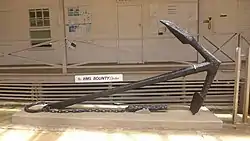 | |
| Established | 2005 |
|---|---|
| Location | Pitcairn Island |
| Type | History and archaeology |
| Website | https://www.government.pn/museum.html |
Pitcairn Island Museum is a museum in Pitcairn Island, a British Overseas Territory in the southern Pacific Ocean. Established in 2005, the museum's collection includes archaeological material from the earliest Polynesian settlers, as well as artefacts from HMS Bounty.
Background
The museum collection was first located within the school; it transferred to a new building in 2005.[1] The new building was funded by the British government.[2] According to researcher Maria Amoamo, during the year 2008 to 2009 the museum only opened once. As of 2015, the museum charged tourists an entry fee of $5.[3]
Collections
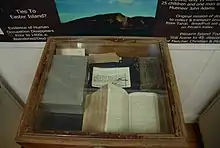
The museum contains ancient artefacts such as stone tools, which were made by Polynesians who lived on the island prior to the arrival of the mutineers.[4] In 1998 archaeologists from James Cook University excavated the wreck of HMS Bounty.[5] Artefacts from the wreck, such as the cannon were conserved at the Queensland Museum before returning to Pitcairn for display.[5] The collection includes other objects, including a wheelbarrow, a Bible thought to be from the Bounty, and various books and articles about the history of Pitcairn Island.[4][6] The collection also includes archival items, such as letters written to family members on Pitcairn from those living on Norfolk Island.[2] Archival research on Pitcairn demonstrated that there had been dispute other ownership of artefacts in the museum, as well as whether they should be in a "museum".[3]
Objects held in overseas collections
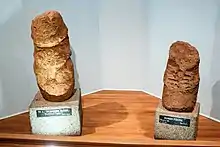
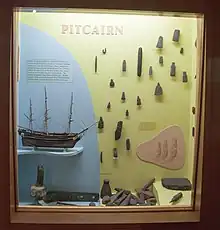
There is a long history of artefacts from Pitcairn Island being traded for goods such as flour, sugar and other essential items. This trade included pre-Mutiny artefacts as well as objects from HMS Bounty.[3] The only surviving example of pre-Mutiny stone sculpture from Pitcairn is a statue held in Otago Museum.[7] The Auckland War Memorial Museum has an extensive collection of stone tools from Pitcairn, including adzes collected by descendants of the mutineers in the 1940s to 1960s.[8][9]
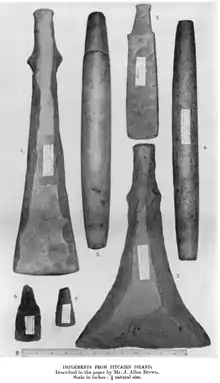
The Pitt Rivers Museum in Oxford also has 93 stone tools from Pitcairn in its collection. The earliest object collected is and adze brought back by William Gunn who was Surgeon General of HMS Curacao. The collection also includes material purchased at auction, that had been published by archaeologist John Allen Brown, whose nephew Lieutenant Gerald Pike had collected objects in November 1897 while he was serving on HMS Comus.[10][11]
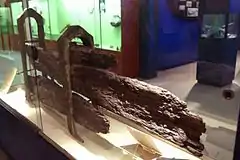
The hammer and anvil from HMS Bounty are held in the collection of the Mariners' Museum and Park in Virginia.[2] Examples of tapa cloth are held in the British Museum and at Kew Gardens, in particular those made by original settlers Mauatua and Teraura.[12] The remains of the Bounty rudder are held in the Fiji Museum.[13]
A rare example of a Laughing Gull found on Pitcairn was deposited at Te Papa in New Zealand.[14]
See also
References
- "Pitcairn Island Museum". MuseumGuide.info. Retrieved 23 November 2016.
- Erskine, Nigel (2004). The historical archaeology of settlement at Pitcairn Island 1790-1856 (phd thesis). James Cook University. p.179, 242, 249.
- Amoamo, Maria (1 February 2013). "(de)Constructing Place-Myth: Pitcairn Island and the "Bounty" Story". Tourism Geographies. 15 (1): 107–124. doi:10.1080/14616688.2012.699093. ISSN 1461-6688. S2CID 144805512.
- Planet, Lonely (1 October 2016). The Travel Book: A Journey Through Every Country in the World. Lonely Planet. ISBN 978-1-78657-398-8.
- Craig, Robert D. (2011). Historical Dictionary of Polynesia. Rowman & Littlefield. ISBN 978-0-8108-6772-7.
- Belton, Frederick A.; Schmieder, Robert W. (2021). "History of domestic cats on Pitcairn Island". International Journal of Maritime History. 33 (2): 289–306. doi:10.1177/08438714211013556. ISSN 0843-8714. S2CID 235599205.
- Stanley, David (1982). South Pacific Handbook. David Stanley. ISBN 978-0-9603322-3-6.
- Turner, Marianne (2010). "The Auckland War Memorial Museum Collection of Adzes from Pitcairn Island, East Polynesia". Records of the Auckland Museum. 47: 129–154. ISSN 1174-9202. JSTOR 42905917.
- Furey, Louise; Ash, Emma (2020). "'Old Stones for Cash'. The Acquisition History of the Pitcairn Stone Tool Collection in Auckland Museum". Records of the Auckland Museum. 55: 1–18. ISSN 1174-9202. JSTOR 27008989.
- Hicks, Dan; Stevenson, Alice (2013). "Easter Island and Pitcairn Island". World Archaeology at the Pitt Rivers Museum: A Characterization. Archaeopress. ISBN 978-1-905739-58-5.
- Brown, John Allen (1900). "Stone Implements from Pitcairn Island". The Journal of the Anthropological Institute of Great Britain and Ireland. 30: 83–88. doi:10.2307/2842620. ISSN 0959-5295. JSTOR 2842620.
- Reynolds, Pauline (2 July 2016). "Tapa Cloths and Beaters: Tradition, Innovation and the Agency of the Bounty Women in Shaping a New Culture on Pitcairn Island from 1790 to 1850". Textile History. 47 (2): 190–207. doi:10.1080/00404969.2016.1211435. ISSN 0040-4969. S2CID 163849896.
- "Fiji Museum | Suva, Fiji Attractions". Lonely Planet. Retrieved 15 April 2021.
- Press, Melbourne. "A vagrant Laughing Gull (Larus africilfa) from Pitcairn Island: A new record for southern and eastern Polynesia." Australian Bird Watcher 13: 34-35.